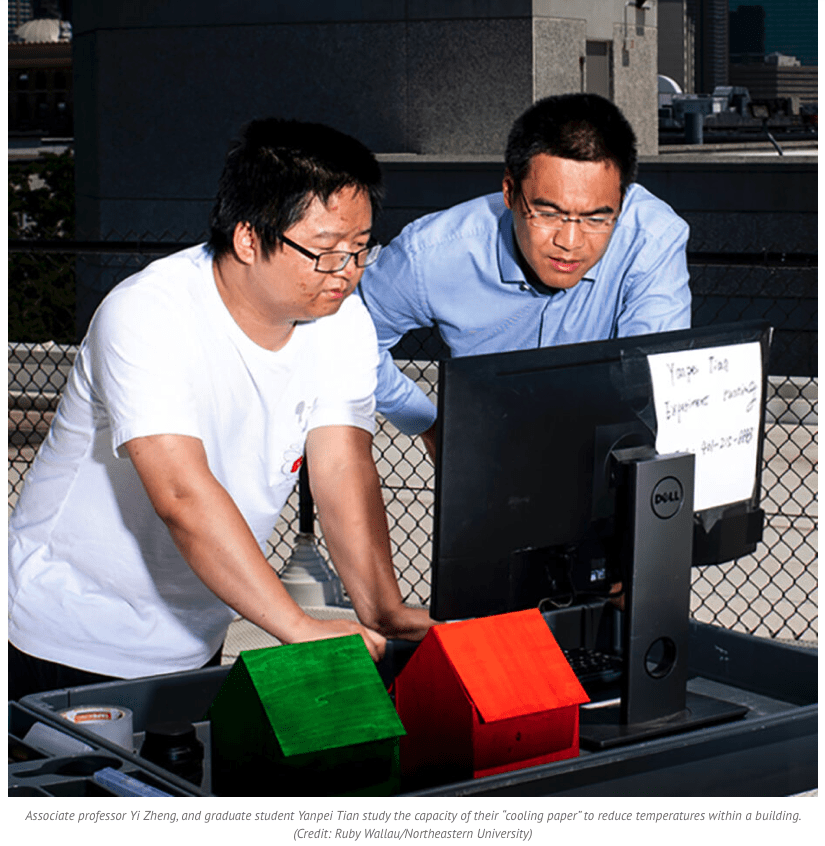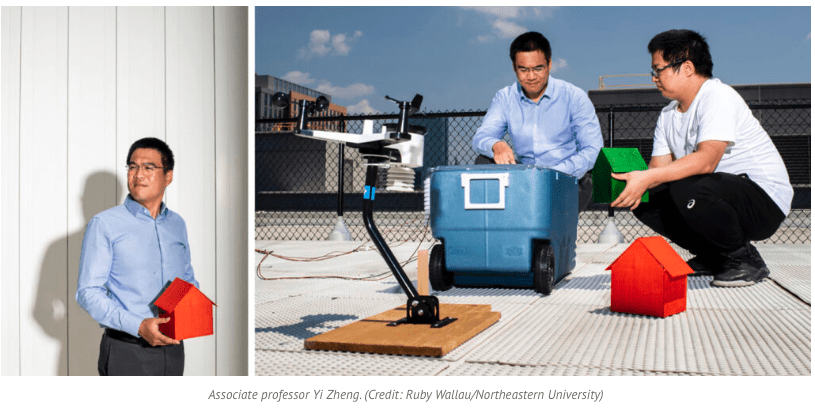What we coat our buildings and rooftops with can significantly influence their ability to reflect the sun’s heat, keep living spaces cooler, lessen our reliance on air conditioners, and overall energy efficiency.
Earlier this year, scientists at Purdue University produced the whitest paint ever created, which they claim reflects 98.1% of sunlight and can produce similar cooling effects as standard air conditioners. Now, an associate professor of mechanical and industrial engineering at Northeastern University in Boston, Yi Zheng, has invented a new way to significantly cool buildings without a cooling system – using a sustainable material called “cooling paper.”
How Cooling Paper Works
The new cooling paper reflects the solar rays away from buildings and sucks the heat out of the interiors. The paper’s porous microstructure contains natural fibers that absorb warmth and re-emits it away from the building. As a result, the paper can be applied to the roofs of commercial buildings and homes or incorporated into building materials for construction

Zheng came up with the invention when he saw a recycling bucket filled with printed paper waste. He recalled thinking, “How could we simply transform that waste material into some functional energy material, composite materials?”
He immediately got to work and started making a pulp using his own high-speed blender. Once the pulp, made from waste paper and the material used to make Teflon, was complete, he formed it into a water-repelling paper that can be used to coat buildings.
Successful Results
When Zheng and his team tested the cooling paper under different humidity levels and temperatures, they found that the paper reduced the interior temperature by 10°F, making a massive difference on a scorching day. “I was surprised when I obtained the same result. We thought there would be maybe 10%, 20% of loss, but no,” Zheng recalled.
According to The Hill, 75% of all homes in the US have air conditioners and are releasing approximately 117 million tons of carbon dioxide into the atmosphere per year. There is no doubt that these appliances are significantly contributing to global warming. Zheng’s new invention could reduce those carbon emissions and electricity use. Another plus is once the material is at the end of its lifecycle, it can be reformed and still perform as well as the original.

Zheng concluded:
The ultimate goal is to reduce global warming. The starting point is to reduce the use of carbon-based materials and also to reduce global warming.
Zheng’s invention was featured in the American Chemical Society journal Applied Materials & Interfaces, and in 2019, National Science Foundation CAREER awarded him for his research.
Benefits Of A Cool Rooftop
A cool roof can significantly benefit a building, its dwellers, and the environment by:
- Extending roof service life
- Reducing energy costs by decreasing air-con needs
- Improving indoor comfort for spaces that don’t have cooling systems, like covered patios or garages
When several buildings in a community have cool roofs, it can:
- Reduce local air temperatures (known as the urban heat island effect)
- Lower peak electricity demand, preventing power outages
- Reduce power plant emissions, such as sulfur dioxide, carbon dioxide, nitrous oxides, and mercury, by minimizing cooling energy use in buildings
How To Keep Cool Without Air-Con
Rising temperatures have been linked to insomnia, dehydration, and in some cases, death. Below are some tips and steps you can follow to beat the heat during the hottest times of the year.
- Take a cold shower when your skin is hot. If you don’t have time to take a full-body wash, you can fill a spray bottle with cool water, then mist yourself.
- Wet your hair, press cold washcloths to hot areas on your body (like the back of your neck), or soak your feet in cold-ice water.
- Fabrics make a huge difference in body temperature; consider light-weight, breathable, moisture-absorbing fabrics that are meant to soak up sweat.
On that note, two Chinese scientists recently developed a new fabric that looks like a regular t-shirt but radiates heat and reflects light to cool the skin temperature by nearly 5°C effectively.

Source: https://www.intelligentliving.co/cooling-paper-made-from-paper-waste-keeps-buildings-10f-cooler/



